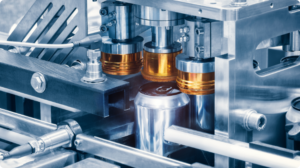Part 2: Mastering Can-Seam Quality
July 9, 2024
From becoming a student to a master, it is not enough to understand the theory, but the applied principles behind each component of the seam. In Part 1 of Mastering Can-Seam Quality, we discussed how can-seam quality (specifically, total package oxygen or TPO) is impacted by the materials used. Though we’re biased, we think it’s worth your time.
But materials aren’t the only thing that makes or breaks can-seam quality. In Part 2: Mastering Can-Seam Quality, we’ll discover the impact of the packaging process and the key factors that affect the quality of can seams. By understanding and implementing these factors, you can meet your standards of quality and productivity at the same time.
Correct Tooling and Condition
The foundation of a quality can seam lies in using the correct tooling. Avoid taking shortcuts; instead, prioritize an investment in high-quality tooling from manufacturers that uphold stringent tolerances, to ensure precision not only in profile but also in bearing assemblies. Remember to select the correct coating for your application needs and verify that the manufacturer applies the coating correctly.
It’s critical that the tooling is regularly maintained, as deteriorated tooling can lead to uneven seams, leaks and result in hold product or unscheduled downtime. To avoid these problems, be sure to have your can seamer tooling inspected and maintained regularly. This will ensure that your tooling is free from cracks, chips, and regular wear and tear. Furthermore, the rolls shouldn’t have a “Roll Rock” of more than .002.
At RSS MACLIN, we provide can-seamer audits, which include a roll inspection, so you can stay ahead of maintenance issues and ensure a high-quality seam. When you partner with RSS MACILN, we’ll take full responsibility for the audit, procurement of parts, and repair. Not only that, but we’ll get you back up to maximum efficiency in no time.
Proper Can-Seamer Set-Up
Another fundamental aspect of mastering can-seam quality is ensuring the seaming machine is properly set-up. During this process, be sure to align and calibrate the machine, tighten the fasteners, and verify the correct settings for can and lid specifications. The correct timing and machine guide rail set up is crucial to deliver the open can into the seamer without can damage.
The attention you devote to this phase will directly affect the accuracy and quality of your seam and have a direct impact on the number of defects on your can-seamer line.
Sound basic? It is. Every can-seamer technician starts somewhere. If you have new members on your team, make sure they get the training they need to succeed. Reach out to us to schedule can-seamer training for your team.
Smooth Can & Lid Transfer

During the dry cell phase, before the cans are filled, it’s important to address any disruptions that might affect the can-seaming process.
Be sure you have a smooth, clean transfer of cans from the depalletizer to the can-seamer machine to obtain a high-quality seam. If any debris or clutter is introduced during the transfer to and from the can-seamer machine, it is sure to impact the integrity of the seam. This can lead to leaks, downtime, and lost profit. To avoid this, maintain a clean workspace around the can-seamer machine.
Before the wet cell, your depalletizer and conveyance’s guide rails and transfer speeds must be set up properly to avoid damaging the can body flange. Ensure a clean Transfer reduce tipping and confirm that the guide rails are properly aligned.
Level Up Your Can-Seam Quality
Don’t waste another dollar on lost product or production time. Reach out to RSS MACLIN. As the can-seamer experts, we’ll help you master your can-seam quality to achieve ultimate productivity, freshness, and customer satisfaction.
Monthly Guide for Can-Seamer Maintenance
Previous BlogNext Blog Title
Next Blog